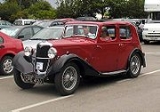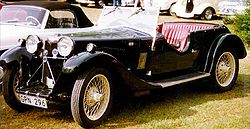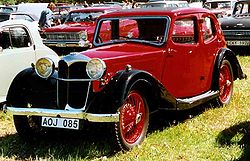
Riley Nine
Encyclopedia



Riley (automobile)
Riley was a British motorcar and bicycle manufacturer from 1890. The company became part of the Nuffield Organisation in 1938 and was later merged into British Leyland: late in 1969 British Leyland announced their discontinuance of Riley production, although 1969 was a difficult year for the UK...
company of Coventry
Coventry
Coventry is a city and metropolitan borough in the county of West Midlands in England. Coventry is the 9th largest city in England and the 11th largest in the United Kingdom. It is also the second largest city in the English Midlands, after Birmingham, with a population of 300,848, although...
, England with a wide range of body styles between 1926 and 1938.
The car was largely designed by two of the Riley brothers, Percy and Stanley. Stanley was responsible for the chassis, suspension and body and the older Percy designed the engine.
The 1087 cc four cylinder engine had hemispherical combustion chambers with the valves inclined at 45 degrees in a crossflow head. To save the expense and complication of overhead camshafts, the valves were operated by two camshafts mounted high in the crankcase through short pushrods and rockers. The engine was mounted in the chassis by a rubber bushed bar that ran through the block with a further mount at the rear of the gearbox. Drive was to the rear wheels through a torque tube and spiral bevel live rear axle mounted on semi elliptic springs.
At launch in July 1926 two body styles were available, a fabric bodied saloon called the Monaco at £285 and a fabric four seat tourer for £235. The saloon could reach 60 mi/h and give 40 mpgimp. Very quickly a further two bodies were offered, the San Remo, an artillery wheeled basic saloon and a 2 seater plus dickie open tourer and there was also the option of a steel panelling rather than fabric for the four seater tourer.
After the cars 1926 launch, Mark 1 production actually started in 1927 at Percy's engine factory, due to some resistance in the main works to the new design. It was such a critically acclaimed success that after less than a thousand cars had been produced the works quickly shut down side valve production and tooled up for the new Nine in early 1928. This switch to the main factory coincided with several modernisations of the Mark 1 - the cone clutch was dropped, the gear lever and handbrake were moved from the right to the centre of the car and a Riley steering box was adopted becoming the Mark II. The Mark III was a gentle update of the II at the end of 1928 , evolving stronger wheels and a different arrangement of rods to the rear brakes.
The Mark IV was a thorough re working of the Nine - heavier Riley made 6 stud axles replaced the bought in 5 stud rod brake items and a new cable braking system was introduced with larger drums.The range of bodies was further extended in 1929 with the Biarritz saloon which was a de-luxe version of the Monaco. The improved brakes were fitted using the Riley continuous cable system and if the cable stretched it could be adjusted from the driver's seat.
More body variants were added over the next few years and in 1934 a Preselector gearbox
Preselector gearbox
A preselector or self-changing gearbox is a type of manual gearbox used on a variety of vehicles, most commonly in the 1930s...
was offered for £27 extra. The range was slimmed down in 1935 to the Monaco saloon, Kestrel streamlined saloon and Lynx four seat tourer as the works started gearing up for production of the new 12 hp model.
In an attempt to keep costs down Riley entered into an agreement with Briggs bodies to produce a steel (non coach-built) body for a newly designed chassis. This new chassis was introduced in 1936 and incorporated such features as Girling rod operated brakes and a prop shaft final drive for the Nine (though the 12hp variant retained the torque tube). The Briggs body was named the Merlin and was available alongside the last nine Kestrel variant, also built on the "Merlin" chassis.
The Briggs body evolved through 1937 with a large boot extension to be called the Touring Saloon and an additional body style was added on the same chassis - the higher specified special series Monaco (a completely new design from the previous car). The final version (and last nine model) was the 1938 Victor also available with 1496 cc engine. The Victor had the engine further forward to increase interior room, the battery moved to the engine bay and smaller diameter wheels.
The Riley company was bought by Lord Nuffield
William Morris, 1st Viscount Nuffield
William Richard Morris, 1st Viscount Nuffield GBE, CH , known as Sir William Morris, Bt, between 1929 and 1934 and as The Lord Nuffield between 1934 and 1938, was a British motor manufacturer and philanthropist...
in 1938 and nine production ceased as the company pursued a strict 2 engine line up, continued after the war with the RM series.
Models
| Type | Year | Notes |
|---|---|---|
| Monaco | 1926-1932 | Fabric Saloon |
| Four seat tourer | 1926- 1931 | |
| Speed Model (Brooklands) | 1927-1931 | Low chassis, cycle wings and pointed tail. Tuned 50 bhp engine. |
| San Remo | 1928- 1929 | Fabric saloon |
| 2 Seater Tourer | 1928- 1930 | Steel bodied |
| Biarritz | 1929- 1932 | De Luxe saloon |
| Plus Series | 1931- 1932 | Rear fuel tank |
| Plus Ultra | 1932- 1933 | Chassis dropped between axles |
| Gamecock | 1931-1932 | Open two seater |
| Kestrel | 1933-1936 | 4 light Streamlined saloon |
| Monaco | 1933-1935 | All alloy bodied version |
| Falcon | 1933-1935 | Saloon |
| Lincock | 1933-1935 | Fixed head coupé |
| Ascot | 1933-1935 | Drop head coupé |
| Lynx | 1933-1936 | Four seat tourer |
| March Special | 1933-1935 | two/four seat sports tourer built by John Charles of Kew |
| Imp | 1933-1935 | 75 mi/h sports version |
| Merlin | 1936-1937 | 4 light all steel streamlined saloon |
| Victor | 1938 | Re-worked Merlin saloon |

